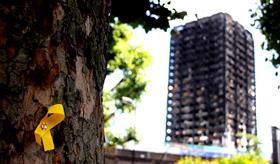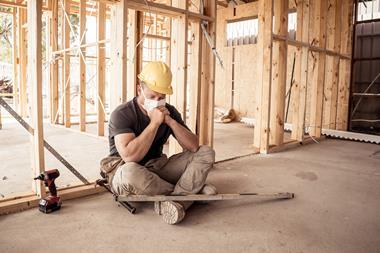In the aftermath of the Grenfell Tower fire, cladding has been a hot topic, with more and more latent defects insurers falling into administration after struggling to pay claims, Insurance Times investigates the wider impact on insurers and brokers
With East West Insurance Company (EWIC) being the latest casualty to go bust in the latent defects insurance saga, insurers and brokers are under increasing pressure.
Latent defects insurance, also known as structural defects insurance, protects policyholders for defects in newly built, converted or refurbished residential developments, such as defective cladding.
October saw EWIC enter administration after struggling to meet the high volumes of claims.
Meanwhile, 2019 saw CRL close its doors to new business after unrated insurer Alpha, which it provided latent and structural home defects for, went bust.
And CBL Insurance collapsed in 2018, but was only directed to stop playing claims on 9 December 2019.
The first phase of the Grenfell inquiry concluded that the ACM cladding as part of the tower blocks refurbishment fuelled the fire in June 2017, subsequently killing 72 people.
According to the Ministry of Housing, Communities and Local Government, there are still 220 high-rise residential and publicly owned buildings still with ACM cladding systems in England – a decrease of only seven since August.
But insurance for all high-rise buildings is still needed and as a result the risk, and subsequently the premiums, are high – in some instances leaseholders are seeing increases surge from £12,000 a year to £180,000.
With more and more latent defects insurers going bust due to the increase in claims from dangerous cladding, what is the impact on brokers and insurers having to deal with this fallout?

Ultimate solution
For many years, the Association of British Insurers (ABI) has looked to the government to resolve this, emphasising that the removal and replacement of dangerous cladding is the ultimate solution.
But, as Laura Hughes, manager of general insurance at the ABI, told Insurance Times: “Replacing inappropriate cladding is not something that a standard buildings insurance policy would cover, as there’s no damage to the property.
“However, where buildings have had the appropriate building warranties for latent defects, we know the remediation has been paid for through those warranties.”
Meanwhile, July saw the government’s draft Building Safety Bill hold leaseholders in high-rise flats accountable for the removal of unsafe cladding as they were forced to foot the entire cost, a move which Matt Hodges-Long, chief executive of TrackMyRisks, previously deemed “an assault on leaseholders”.
The problem is that most leaseholders cannot pay this charge, which means they would have to declare bankruptcy and therefore the property would in turn be repossessed.
This means that leaseholders are held “captive” as they lack agency over the insurance cost paid, Hodges-Long said that should classed as vulnerable customers
”It’s a forced requirement from the freeholder, it’s within the lease, and the mechanism for recovering that is through the service charge in the lease. If [the leaseholder] refuses to pay for buildings insurance, the freeholder could issue forfeit proceedings, if they go through it ultimately means the lease is taken away,” Hodges-Long said.
Therefore, Hughes stressed there is an “urgent need for building owners and the government to step in” to assist in cladding removal.
’Symptomatic failure’

When asked why insurance premiums were so high, Hughes said: “Insurance is a business based on pricing risk.
”The unfortunate reality is that some types of cladding have been proven to present a risk to occupants and to buildings, and the insurer is there to pick up that risk.
“Unfortunately, the more dangerous buildings are going to have more expensive premiums. However, once buildings have had combustible cladding replaced, they are likely to be seen by insurers as lower risk, which in turn is likely to result in a reduction in premiums.”
The ABI has been engaging with some leaseholder groups, government officials and ministers on the matter.
Hughes added that it is “symptomatic of a failure in building regulation regimes to have allowed cladding to be put on in the first place”.
But she admitted that more than three years after the Grenfell tragedy, insurers have learnt a lot more about combustible cladding, construction matters and their associated risks, which means they can price more accurately.
Challenging times
Speaking about how the warranty and latent defects market has retrenched, Phillip Lamb, associate director of Clear MPW, listed some of the challenges brokers are facing.
The first being restricted capacity following some insurers leaving the marketplace. Due to this, he continued “a number of managing agents approved by the Council of Mortgage Lenders (CML) have had to seek new insurer backing”.
In addition to this, Lamb said the rates are hardening following claims for example with water ingress being a particular problem (water from the outside entering the building), timescales to secure quotes being extended, technical appraisals of underwriting information could be more interrogative, formal quotes take longer and the terms and premiums are more likely to exceed client expectations.
“I can only see this getting worse in the short-term unless new market capacity becomes evident,” he added.
How many policyholders are affected by EWIC’s collapse?
The Financial Services Compensation Scheme (FSCS) stepped in when EWIC collapsed to protect most policies sold to UK individuals and small businesses as the firm could no longer pay claims.
The number of policies with live exposures was thought to be 8,000 as of 12 October, and it had a portfolio of structural defects policies that were 10 to 15 years, which were transferred from Zurich in 2018.
Jimmy Barber, chief operating officer at FSCS, told Insurance Times: “Currently, all EWIC insurance policies remain valid and FSCS is working closely with the joint administrators to understand what effect the insolvency of the firm will have on those policies.”
It follows a rule change by the Prudential Regulation Authority (PRA) on 8 October which means that policyholders of building guarantee policies which includes structural defects insurance will be covered for the full value of a claim.
Barber continued: “Most of the claims against EWIC relate to structural defects policies covering issues such as defective cladding. FSCS will protect most UK-based customers of East West who are individuals or small businesses with an annual turnover of less than £1m.”
What is latent defect insurance?
Latent defects insurance is a requirement for most UK mortgage lenders before they release funds for the purchase of a property if the house is new or under 10 years old.
It is also referred to as structural defects insurance, structural warranty, self-build insurance, building warranty or construction insurance.
It protects policyholders for defects in newly built, converted or refurbished residential developments and for the potential cost of rebuilding or rectifying defects.
It is purchased by the building owner, usually the freeholder; and the cost of that insurance is then spread among the properties within the block via an annual service charge.
Hosted by comedian and actor Tom Allen, 34 Gold, 23 Silver and 22 Bronze awards were handed out across an amazing 34 categories recognising brilliance and innovation right across the breadth of UK general insurance.




















































No comments yet